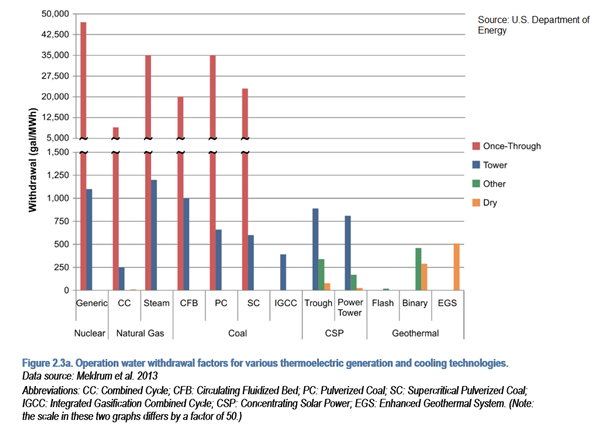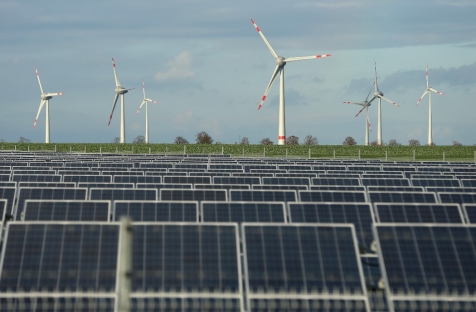 Several years ago, at the height of the nuclear “renaissance” when the Nuclear Regulatory Commission was reporting that it received or was expecting some 30 new reactor license applications, I met with a group of Capitol Hill staffers generally skeptical of nuclear power.
Several years ago, at the height of the nuclear “renaissance” when the Nuclear Regulatory Commission was reporting that it received or was expecting some 30 new reactor license applications, I met with a group of Capitol Hill staffers generally skeptical of nuclear power.
To be honest, I don’t remember what the main topic of the meeting was. But toward the end I brought up the issue of whether anyone in the federal government had ever looked at the impact of a major new reactor construction program on U.S. water supplies. Nothing but blank stares. I suggested it might be a really good idea to do so since nuclear reactors were being proposed in several areas that at the time were experiencing drought conditions, and since reactors use far more water per megawatt/hour of electricity produced than any other generation source.
And, given that the industry and some Congressmembers at the time were advocating for 100 or more new reactors (some Congressmembers are probably futilely still advocating that, but it’s not gonna happen), the impact on our drinking and agricultural water supplies would be highly significant. It seemed obvious that someone with a lot more resources than NIRS should be looking at that.
Everyone nodded their heads and agreed that, oh yes, that would be important. And the issue was undoubtedly forgotten or dismissed before they even walked out of the room.
NIRS did try to raise funds to do some of that work, and also to try to sort out the myriad of federal, regional and state laws and regulations governing water withdrawals and use so that grassroots activists would at least be able to participate somewhat knowledgeably and effectively in water permit issues. We partnered with some other groups on proposals and submitted to several foundations. No luck there either.
Since then we’ve joined with the American Clean Energy Agenda (ACEA), composed of a few national and dozens of grassroots groups working against dirty energy technologies and for a clean energy system. The energy/water nexus has been a major focus of that work, and last September ACEA issued a major report on energy and water issues. For our part, we’ve also put up a section on our website on water and reactors, linking to a few useful documents.
Now, finally, the Department of Energy has released a major new study on the water/energy nexus. You can find it and the executive summary here.

The report is on target in a lot of its analysis. It includes an entire chapter on the impact of climate change on water and energy. It points out that most renewables require virtually no water to operate. It points out that some nuclear reactors in recent years have had to shut down because intake water temperatures had become too high and exceeded their technical specifications. It recognizes the growing use of renewables as essentially water-free technology (by the way, according to a press release today from the Sun Day Campaign, renewables accounted for 88% of all new U.S, generating capacity in May, and so far are at 54% of all new capacity for the year. New nuclear capacity, of course, remains at zero). And, as the chart on the top of this post taken from its report clearly indicates, DOE recognizes that nuclear power is the largest consumer of water among generation sources by a wide margin. Solar and wind, other than concentrated solar power, which does require some water to operate, don’t even appear on the chart since their consumption is minimal.
Nuclear advocates might argue that much of the enormous amount of water required by nuclear reactors with once-through cooling systems, as shown in the above chart, is returned to its source–normally a river, lake or the ocean. But, as NIRS documented in its 2001 report Licensed to Kill, that water is returned at a much higher temperature, causing devastation of marine life in the region of those reactors. Reactors with cooling towers withdraw less water from their source, but return a much lower percentage of that water–much of it is evaporated by the towers. And, of course, reactors tend to release radioactive materials into water, especially radioactive tritium–which has occurred at about three-quarters of U.S. reactor sites. Releases of other radionuclides also has been documented.
Unfortunately, but as expected given the DOE’s inane “all of the above” energy strategy, the report is short on solutions and recommendations. It simply refuses to connect the dots and acknowledge that the single best step the U.S. can take to protect precious water supplies is to replace reactors with renewables as quickly as possible. That’s certainly not the only step: natural gas–especially fracking–and coal use and pollute a lot of water too. That’s just one more reason why full implementation of a nuclear-free, carbon-free energy system should be the nation’s number one energy priority. That it isn’t is not a failure of technology, it’s a failure of political will and foresight. Good ideas don’t just happen on their own, especially when there are powerful forces working against them for their own benefit. That’s why it’s up to all of us to educate, organize, mobilize and keep up the political pressure at every possible opportunity.
Michael Mariotte
June 23, 2014
Permalink: https://www.nirs.org/2014/06/23/nuclear-power-and-water-doe-almost-gets-it/
You can now support GreenWorld with your tax-deductible contribution on our new donation page here. We gratefully appreciate every donation of any size–your support is what makes our work possible.
Comments are welcome on all GreenWorld posts! Say your piece above. Start a discussion. Don’t be shy; this blog is for you.
If you like GreenWorld, you can help us reach more people. Just use the icons below to “like” our posts and to share them on the various social networking sites you use. And if you don’t like GreenWorld, please let us know that too. Send an e-mail with your comments/complaints/compliments to nirs@nirs.org. Thank you!
Note: If you’d like to receive GreenWorld via e-mail daily, send your name and e-mail address to nirs@nirs.org and we’ll send you an invitation. Note that the invitation will come from a GreenWorld@wordpress.com address and not a nirs.org address, so watch for it.



